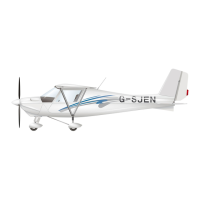C42 Owner’s Manual (Microlight) Page 12
Variations in rpm and cruise performance occur with different loads.
Typical cruising flight (80 hp)
Engine speed: 4500 rpm.
Airspeed: 95 mph (83 kt)
Fuel flow: 2.8 Imp. gallons per hour, (12.7 l/h)
The maximum speed in cruising flight is 118 mph (103 kt).
Note:
This maximum speed applies only in smooth conditions with no turbulence. In
turbulent air, speed must be kept below V
A
= 94 mph (82 kt).
4.04 Turning flight:
In turning flight, it is necessary to co-ordinate the use of the ailerons and the rudder. At normal
cruising speeds 80 mph (70 kts) to 103 mph (90 kts) initiate the turn with aileron maintaining
balance as necessary with rudder. At bank angles exceeding 45 degrees the pitch trim force
required to maintain level flight increases noticeably. Banks exceeding 60 degrees are
prohibited. In steep bank turns remember to maintain the attitude at entry and maintain
airspeed with power. Failure to maintain correct attitude can result in a spiral dive developing. At
60 degrees of bank the stall speed is multiplied by a factor of 1.41 and you will be pulling 2g.
4.05 Slow
flight, stalling and use of flaps:
In cruising flight configuration with the landing flaps retracted and at speeds below 60 mph (52
kt) the top of the engine cowl will be well above the horizon. Control inputs of the aileron and
rudder will be severely dampened and the overall response of the aircraft markedly reduced.
Only gentle turns should be made of up to 20 degrees of bank ensuring the aircraft remains in
balance. In slow flight if a wing drops, centrally reduce back pressure on the stick and lower the
nose. Prevent further yaw with the rudder and do not attempt to lift the wing by aileron input.
At approximately 48 mph (42 kt) there will be a slight buffeting of the airframe. The aircraft is still
controllable. However, aileron input should not be used and the stick kept central with any
tendency for the wing to drop use opposite rudder to prevent yaw.
If stalls are entered very gently the aircraft can enter a controlled mushing descent, control can
still be maintained with rudder. (It is important not to over use rudder and potentially put the
aircraft into a reverse spin entry).
When the aircraft stalls the nose will drop. By removing back pressure the aircraft should recover.
Typical height loss in the wings-level stall is approximately 100 ft., and max. Pitch attitude change
25° below the horizon. In turning flight stalls the typical height loss is 120 ft. At full flap (40
degrees) the pre-stall buffet, 39 mph (34 kts), is markedly more noticeable and there is an
increased tendency for the wing to drop if balanced flight is not maintained.
Speeds are as follows:
VS1 flaps retracted (0°) 47 mph, (41 kts)
VS2 first notch of flaps (15°) 42 mph, (36 kts)
VS0 full flaps ( 40°) 37 mph, (32 kts)
The above specified stall speeds will vary slightly depending on the all up weight.
Spinning

